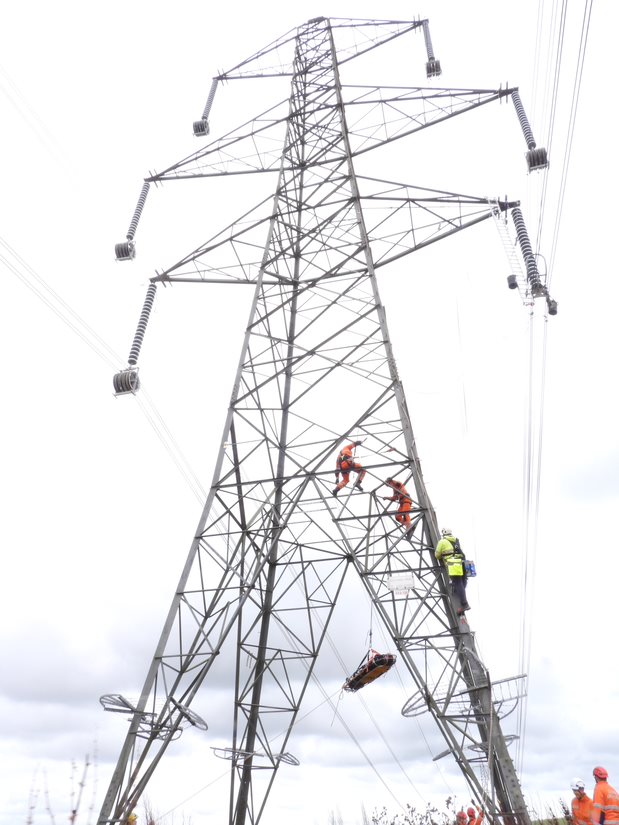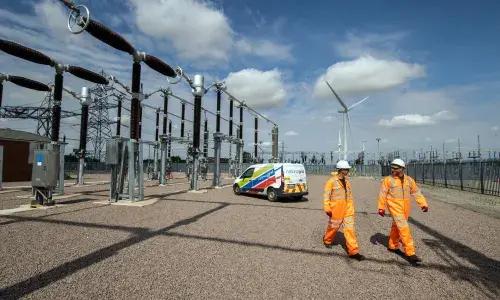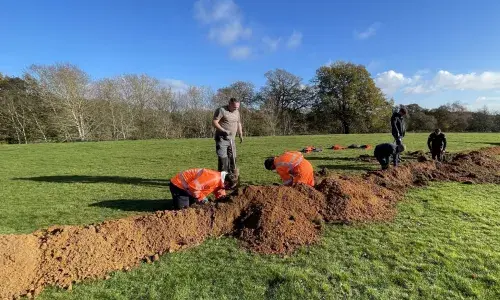
Fire and rescue teams test their skills on National Grid pylons
- Dorset & Wiltshire Fire and Rescue perform rescue drills on the National Grid Dorset Visual Impact Provision (VIP) site
- 45m disconnected pylons are ideal for training as a live electricity circuit makes these exercises usually impossible
- The team simulated two scenarios in real rescue conditions.
Collaboration and teamwork were in evidence once again as National Grid and Morgan Sindall Infrastructure worked with Dorset & Wiltshire Fire and Rescue to create a unique opportunity to perform rescue drills on the National Grid Dorset Visual Impact Provision (VIP) site.
On Friday 30 September, the Fire and Rescue team practiced a variety of rescue operations on an unelectrified pylon, on the downland above Winterbourne Abbas, prior to its removal as one of 22 being taken down as part of the Dorset VIP project.
Transmission pylons are usually live meaning that opportunities to perform rescue drills on them are incredibly rare. This unusual exercise allowed the team to experience carrying out rescue operations at height on a 400kV electricity pylon for the first time.
Following an induction and overhead line briefing on casualty call out scenarios from Elliot Moor, Construction Manager for Morgan Sindall Infrastructure, the Fire and Rescue team simulated two scenarios in real inclement weather rescue conditions.
All rescue drills were risk assessed and managed closely to ensure everyone’s safety. They included a stretcher for a team member playing an incapacitated casualty, as pictured.
Chances to carry out rescue drills like this on 45m high pylons are rare for the local Fire and Rescue teams but they give the crews training that could be vital in an emergency so we were delighted to help.
Paul Hamnett, Senior Project Manager for National Grid, said: “This project aims to enhance the Dorset Area of Outstanding Natural Beauty, and we’re doing that not just through removing 22 pylons, but also by offering opportunities that deliver additional benefits for the local community. Chances to carry out rescue drills like this on 45m high pylons are rare for the local Fire and Rescue teams but they give the crews training that could be vital in an emergency, so we were delighted to help.”
John Wickham, Dorset and Wiltshire Fire and Rescue added: “The technical climbing and procedural knowledge input by Elliot and the rest of the team was invaluable. We’ve found the sessions to be so useful that we’re organising another one later in the month and before all 22 pylons come down so that more of the Fire and Rescue team can benefit from this opportunity.”
Elliot Moor said: “My father was part of the team who first erected these pylons 50 years ago and it is great to play my part in the evolving legacy of the landscape. Being able to help the Fire and Rescue Service as we go about our work is an additional bonus and we very much enjoyed working with the local team.”
Pylon 4YA 198 above Winterbourne Abbas was used as the site for the rescue drills and is part of an 9km section of overhead transmission line in the Dorset Area of Outstanding Natural Beauty (AONB) set to be removed. The overhead line has been replaced with electric power cables buried underground which are already in operation.
The scheme aims to enhance the landscape near the villages of Friar Waddon, Martinstown and Winterbourne Abbas, as part of National Grid’s Visual Impact Provision project* to reduce the visual impact of existing high voltage power lines in protected areas across England and Wales.
Contact for media information only:
Helen Blake
+44 7790 824788 [email protected]
*About Visual Impact Provision
All electricity transmission owners are funded by a price control mechanism which is agreed with and set by Ofgem, the electricity and gas markets regulator. Ofgem has agreed a set of price controls and incentives for the period from April 2021 to March 2026, following the previous period (2013-2021). The new price controls and incentives include a provision of £465 million to mitigate the visual impact of existing electricity infrastructure in nationally protected landscapes in Great Britain.
For National Grid, which is the electricity transmission owner in England and Wales, this means considering the visual amenity of our existing infrastructure in Areas of Outstanding Natural Beauty (AONBs) and National Parks.
In addition to the VIP project in Dorset, National Grid is also progressing plans to replace existing electricity infrastructure in three other protected landscapes, including the North Wessex Downs Area of Outstanding Natural Beauty and Peak District National Park where construction has begun, and Snowdonia National Park.
The project has advised throughout by an independent panel of senior landscape experts from leading environmental organisations including the National Trust, the Ramblers, the Landscape Institute and the Campaign for National Parks plus CPRE, Natural England, Historic England, and their Welsh counterparts. The Group is chaired by environmentalist and broadcaster, Chris Baines.
About the Dorset Area of Outstanding Natural Beauty:
The Dorset Area of Outstanding Natural Beauty covers over 40% of Dorset, stretching from Lyme Regis in the west, along the coast to Poole Harbour in the east, and north to Hambledon Hill near Blandford Forum. The Dorset AONB Partnership brings together 20 organisations to conserve and enhance the natural beauty of this nationally important protected landscape. Find out more about the Dorset AONB and the work of the Partnership at www.dorsetaonb.org.uk.
Areas of Outstanding Natural Beauty (AONBs), are exceptional landscapes whose distinctive character and natural beauty are precious enough to be safeguarded in the national interest. The Dorset Area of Outstanding Natural Beauty is one of 46 AONBs in the UK, protected and enhanced for nature, people, business and culture. For further information about the AONB network visit www.landscapesforlife.org.uk


